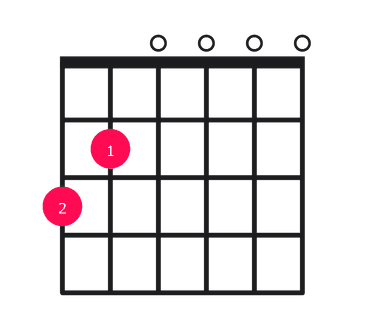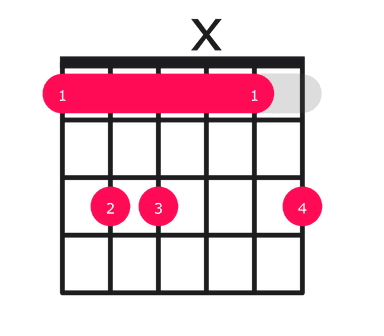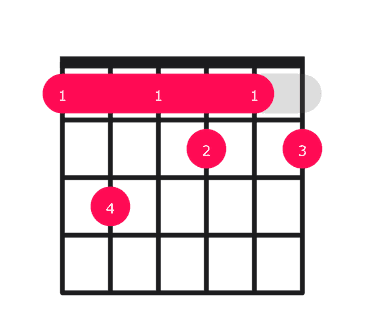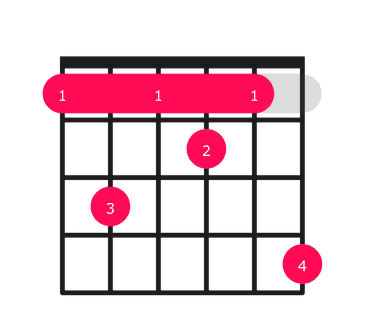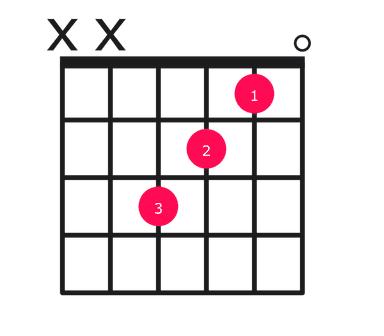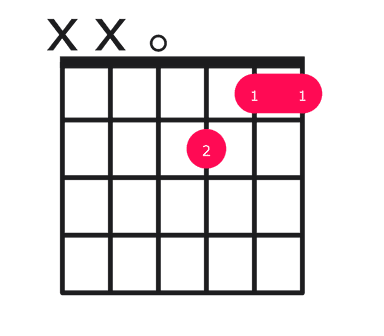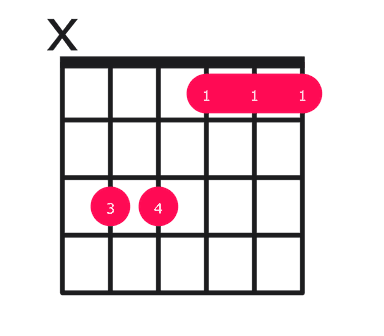How to play the F6 chord on guitar
Spice up your playing with this jazzy chord, used in hits like "Moondance."
The F6 chord
The F6 chord, pronounced "F sixth," is a colorful and versatile chord that adds a touch of sophistication to your guitar playing. It's built on the foundation of an F major triad with an added sixth note, creating a rich and dreamy sound. The F6 chord is commonly used in genres like jazz, soul, and R&B, and can be heard in popular songs.
There are many ways to play a chord. Here's a diagram for the most common F6 chord. We've also included other versions below.

Unlock your playing potential in online guitar lessons with experts on Til. Start today and achieve your guitar goals quickly. Find a top-rated teacher.
Finger placement for F6 chord
The F6 chord is typically played as a barre chord on the 1st fret of the guitar.
Follow these finger positions to play a F6 chord on your guitar:
- Place your index finger on the 1st fret of the 1st (high E), 2nd (B), 3rd (G), 4th (D), 5th (A), and 6th (low E) strings, forming a barre.
- Place your middle finger on the 2nd fret of the 3rd (G) string.
- Place your ring finger on the 3rd fret of the 5th (A) string.
- Place your pinky finger on the 3rd fret of the 4th (D) string.
To strum the F6 chord, use a downward motion to play all six strings simultaneously. Make sure to apply enough pressure with your index finger to properly fret all the strings in the barre.
How to play an easy F6 chord on guitar
If you're a beginner looking to play a simpler version of the F6 chord, try playing an F major chord instead. Place your index finger on the 1st fret of the 1st (E) string, your middle finger on the 2nd fret of the 3rd (G) string, and your ring finger on the 3rd fret of the 4th (D) string.
How to play a F6 bar chord
The F6 guitar chord is typically played as an open chord, but learning the barre chord version can make it easier to transition between chords and add variety to your playing.
Here's how to play an F6 barre chord:
- Place your index finger across the 1st fret, covering all six strings (barre).
- Place your middle finger on the 2nd fret of the 3rd (G) string.
- Place your ring finger on the 3rd fret of the 5th (A) string.
- Place your pinky finger on the 3rd fret of the 4th (D) string.
- Strum from the low E string down.
Common F6 chord progressions
The F6 chord is often used in progressions to add a dreamy, nostalgic, or bittersweet feel to a song. Some common chord progressions featuring the F6 chord include:
- I - vi - IV - V (F6 - Dm - Bb - C)
- ii - V - I (Gm7 - C7 - F6) Used in "Stella by Starlight"
- I - vi - ii - V (F6 - Dm - Gm - C)
- iii - vi - ii - V (Am - Dm - Gm - C)
- vi - IV - I - V (Dm - Bb - F6 - C) Used in "Still Crazy After All These Years" by Paul Simon
Drills to master the F6 chord
Mastering the F6 chord on guitar can be achieved through targeted drills. One effective exercise is to play each note of the chord individually, focusing on clarity and precision. Strum the F, then the A, followed by the C and D notes separately, ensuring each rings out cleanly.
Another drill involves transitioning between the F6 chord and other common chords, such as C or G. Practice switching back and forth smoothly, maintaining a steady rhythm. Over time, your fingers will develop muscle memory, making the F6 chord feel more natural and effortless to play.
Unlock your playing potential in online guitar lessons with experts on Til. Start today and achieve your guitar goals quickly. Find a top-rated teacher.
Nelly M.
"I've already learned so much my brain hurts! Tash has given me some simpler things to work on since I'm a beginner. I've taken several of the Til classes and they are such a great way to learn."
Songs that feature the F6 chord
Here are 10 popular songs you can play with the F6 chord.
- Purple Rain by Prince (F, C, Dm, Bb)
- Santeria by Sublime (D, Bm, G, A)
- Sugar, We're Goin Down by Fall Out Boy (G, Gm, F, C)
- Lady Madonna by The Beatles (A, D, F, G, C)
- Daughters by John Mayer (F#m, D, A)
- No Woman, No Cry by Bob Marley & The Wailers (C, G, Am, F)
- Runaway by Kanye West (F#m, E, D)
- All You Need Is Love by The Beatles (G, D, Em, G7, D7)
- Landslide by Fleetwood Mac (Eb, Bb, F, C)
- Clocks by Coldplay (Eb, Bb, F)
How a guitar teacher can help
If you feel stuck in your playing, it might help to take personalized guitar lessons with an expert guitarist. Taking lessons with a pro gives you access to the skills, feedback, and motivation to reach your goals.
You can find expert guitar teachers to support you in the journey. Thousands of people have turned to online guitar lessons on Til, instead of traditional in-person lessons, because Til gives you access to the best teachers in the world from the comfort of home. And with flexible scheduling, secure payments, lesson recordings, and a private chat with your teacher–there’s never been a better way to learn guitar.






